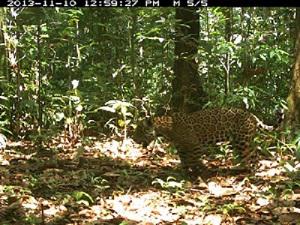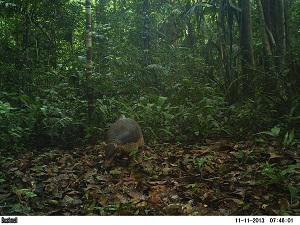Hugo Cardoso de Moura Costa
Other projects
24 May 2018
White-Lipped Peccary Conservation Within and Outside Amazonian Extractive Reserves
This project will provide the first data on the population of this species at this high priority area for jaguar conservation located along the arc of deforestation in south-eastern Brazilian Amazonia and will attempt to reduce the slaughter of jaguars by ranchers.

Jaguar Panthera onca captured by a camera trap at Médio Juruá Extractive Reserve, Carauari, Amazonas, Brazil.
Due to habitat loss, hunting for the fur trade and persecution following livestock loss, the Near Threatened jaguar (IUCN 2008) is estimated to be absent from 56% of its original range. Recent studies indicate that there is genetic connectivity between remnant populations but that urgent conservation strategies are needed to maintain these linkages. A “range-wide conservation strategy” was proposed during a workshop - Jaguars in the New Millennium - held in Mexico in 1999. Experts identified 90 areas key for the survival of jaguars called “Jaguar Conservation Units” (JCUs). Amazonia is the largest, with more than six million square kilometres, and the most biodiverse rainforest in the world. It is estimated that one-third of global biodiversity is contained within its limits, and it represents approximately 70% of the jaguar’s total area of occurrence and also serves to connect populations from other important ecosystems. As Brazil contains the vast majority of the Amazon it plays a vital role in jaguar conservation.

Giant armadillo Priodontes maximus camera trap photo at Uacari Sustainable Development Reserve, Carauari, Amazonas, Brazil.
Since the 1970s, the Brazilian government has stimulated the occupation and development of this region, for cattle ranching, agricultural settlements, timber extraction, mining and hydroelectric dams. Between 1988 and 2011 over 392,201 km² of the Amazon has been deforested, mainly along the well-known “arc of deforestation” at the south and east limits. This rapid process of deforestation has resulted in small and isolated subpopulations, with high extinction probability. In addition to the huge habitat loss, felids have come into increasing conflicts with humans. Attacks on livestock at forest frontiers are occurring more frequently as carnivores adapt to a reduction in natural prey, by including livestock in their diets. It is estimated that 0.56 large cats are killed per 100 km² at the proposed study area.
Given the high rates of deforestation in the Amazon and the lack of studies on jaguar’s populations for this biome in Brazil, the main objective of this project is to survey jaguar population parameters at a Conservation Unit located in a high priority JCU 68 Cayabi in southern Brazilian Amazonia.